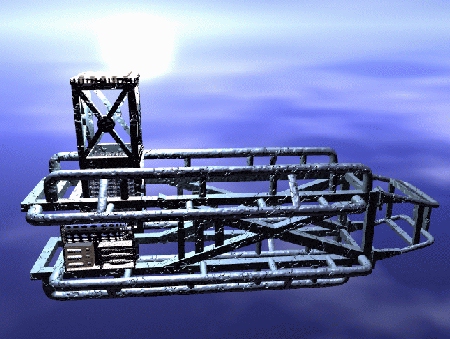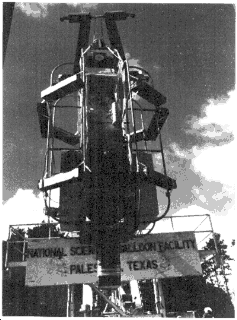
 |
Hailey's Telescope |
|
Alice Springs, Australia October 8, 1995 -- The natives were restless in the Northern Territory of Australia, and it wasn't just because Columbia University's Chuck Hailey was paying them a visit. Flying at an altitude of about 125,000 ft, Professor Hailey's gamma ray telescope searched the heavens for black holes and neutronstars as scientists fidgeted nervously. | |
 
|

|
|
NASA-supported research Under the auspices of NASA, this gamma ray telescope is part of ongoing research being conducted in High Energy Astro Physics. The primary goal of this particular NASA program is to promote the design of telescopes that can be flown on balloon platforms, a set-up that enables gamma ray, cosmic ray, and atmospheric research. "Black holes and neutron stars often are strong emitters of gamma radiation." says Hailey. "As material spirals down onto the surface of the neutron stars or the center of the black hole, the material heats up as it falls in and tends to emit very intense gamma rays. So gamma rays are a very good tool for gaining a better understanding of energy generation of black holes and neutron stars." High quality data obtained during this past flight is to be analyzed over the next several years. Before the next flight, the gamma ray telescope has to be recalibrated with radioactive sources. These sources of energies, ranging from 30 to 150 kilobolts, must be placed far away from the gamma ray telescope until they form images that resemble gamma ray stars. The images can then be recorded and analyzed to make sure that the telescope is reading targets as expected.
| |
 
|

|
|
The Beauty of the "Shadow Mask"
The gamma ray telescope has a coded aperture mask known as a "shadow mask". This mask allows a source to cast the shadow of the holes onto the detector plane. As the source moves, this pattern of pinhole shadows occurring on the focal plane also move. By looking at this pattern of pinholes on the detector plane, scientists can reconstruct the location of a source. The detector plane is a scintillator crystal phototube combination which consists of a Cesium Iodide cellular crystal mounted on top of an imaging photo multiplier tube. There are thirty six crystalphototube combinations all over with their own little masks. These thirty six coaligned telescopes add up to the area of one big telescope. This multiple telescope array is aimed to compensate for the failures of an individual telescope. Students Vital to Project Much of the original gamma ray telescope was built by undergraduate students. Virtually, the entire electronics package was assembled by undergraduates and probably ten to thirty thousand lines of the code was written by engineering and physics undergraduates. Hailey and his team are currently researching ways of building a more sensitive gamma ray telescope which uses a real gamma ray mirror as opposed to the shadow mask. "We certainly think that as we build a new payload we will have a large number of undergraduates involved," says Hailey. "It's a very sophisticated multimillion dollar project and promises to be a unique experience for the students. There is nothing like hands-on-experience for physics and engineering students." | |

|
The 100 Inch (Hooker) Telescope The Bradford Robotic Telescope How to Choose a Quality Telescope for Under $500.00 NASA Infrared Telescope Facility |
 |
| Moment Home Page |
Current Article Index |
Search |
Back Issues |